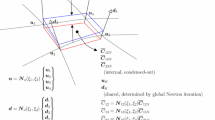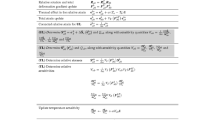Abstract
The corotational method for frame-invariant elements is generalized to obtain a consistent large-strain shell element incorporating thickness extensibility. The resulting element allows arbitrary in-plane deformations and is distinct from the traditional corotational methods (either quadrature-based or element-based) in the sense that the corotational frame is exact. The polar decomposition operation is performed in two parts, greatly simplifying the linearization calculations. Expressions for the strain-degrees-of-freedom matrices are given for the first time. The symbolic calculations are performed with a well-known algebraic system with a code generation package. Classical linear benchmarks are shown with excellent results. Applications with hyperelasticity and finite strain plasticity are presented, with asymptotically quadratic convergence and very good benchmark results. An example of finite strain plasticity with fracture is solved successfully, showing remarkable robustness without the need of enrichment techniques.
Similar content being viewed by others
References
Allman DJ (1988) Evaluation of the constant strain triangle with drilling rotations. Int J Numer Methods Eng 26: 2645–2655
Alvin K, de la Fuente HM, Haugen B, Felippa CA (1992) Membrane triangles with corner drilling freedoms: I. The EFF element. Finite Elem Anal Des 12: 165–187
Antman SS (2005) Nonlinear problems of elasticity, 2nd edn. Springer, New York
Areias P Simplas. http://home.uevora.pt/~pmaa/SimplasWebsite/Simplas.html
Areias P, Dias-da-Costa D, Alfaiate J, Júlio E (2009) Arbitrary bi-dimensional finite strain cohesive crack propagation. Comput Mech 45(1):61–75
Areias P, Rabczuk T (2010) Smooth finite strain plasticity with non-local pressure support. Int J Numer Methods Eng 81: 106–134
Areias P, Ritto-Corrêa M, Martins JAC (2010) Finite strain plasticity, the stress condition and a complete shell model. Comput Mech 45: 189–209
Areias P, Van Goethem N, Pires EB (2010) A damage model for ductile crack initiation and propagation. Comput Mech (in Press)
Basar Y, Ding Y (1992) Finite rotation shell elements for the analysis of finite rotation shell problems. Int J Numer Methods Eng 34: 165–169
Batoz J-L (1980) A study of three-node triangular plate bending elements. Int J Numer Methods Eng 15: 1771–1812
Battini J-M (2004) On the choice of local element frame for corotational triangular shell elements. Commun Numer Methods Eng 20: 819–825
Battini J-M, Pacoste C (2006) On the choice of the linear element for corotational triangular shells. Comput Method Appl Mech Eng 195: 6362–6377
Belytschko T, Liu Wk, Moran B (2000). Nonlinear finite elements for continua and structures. Wiley, New York
Bergan PG, Felippa CA (1985) A triangular membrane element with rotational degrees of freedom. Comput Methods Appl Mech Eng 50: 25–69
Bergan PG, Nygaard MK (1984) Finite elements with increased freedom in choosing shape functions. Int J Numer Methods Eng 20: 643–663
Brank B, Ibrahimbegovic A (2001) On the relation between different parametrizations of finite rotations for shells. Eng Comput 18: 950–973
Crisfield MA, Moita GF (1996) A unified co-rotational framework for solids, shells and beams. Int J Solids Struct 33(20–22): 2969–2992
Dvorkin E, Pantuso D, Repetto E (1995) A formulation of the MITC4 shell element for finite strain elasto-plastic analysis. Comput Methods Appl Mech Eng 125: 17–40
Eberlein R, Wriggers P (1999) Finite element concepts for finite elastoplastic strains and isotropic stress response in shells: theoretical and computational analysis. Comput Methods Appl Mech Eng 171: 243–279
Felippa CA (2003) A study of optimal membrane triangles with drilling freedoms. Technical report CU-CAS-03-02, University of Colorado, College of Engineering, Campus Box 429, Boulder, Colorado 80309, February 2003
Felippa CA, Alexander S (1992) Membrane triangles with corner drilling freedoms: III. Implementation and performance evaluation. Finite Elem Anal Des 12: 203–239
Felippa CA, Haugen B (2005) Unified formulation of small-strain corotational finite elements: I. Theory. Comput Methods Appl Mech Eng 194: 2285–2335
Felippa CA, Militello C (1992) Membrane triangles with corner drilling freedoms: II. The ANDES element. Finite Elem Anal Des 12: 189–201
Goldstein H, Poole CP, Safko JL (2001) Classical mechanics, 3rd edn. Addison-Wesley, New York
Hughes TJR (2000) The finite element method. Dover, 2000. Reprint of Prentice-Hall edition, 1987
Hughes TJR, Carnoy E (1983) Nonlinear finite element formulation accounting for large membrane stress. Comput Methods Appl Mech Eng 39: 69–82
Jetteur P (1987) Improvement of the quadrilateral jet shell element for a particular class of shell problems. Technical report IREM Internal Report 87/1, Ecole Polytechnique Fédérale de Lausanne
Klinkel S, Gruttmann F, Wagner W (2008) A mixed shell formulation accounting for thickness strains and finite strain 3D material models. Int J Numer Methods Eng 74: 945–970
Korelc J (2002) Multi-language and multi-environment generation of nonlinear finite element codes. Eng Comput 18(4): 312–327
Liu WK, Guo Y, Belytschko T (1998) A multiple-quadrature eight-node hexahedral finite element for large deformation elastoplastic analysis. Comput Methods Appl Mech Eng 154: 69–132
MacNeal RH, Harder RL (1985) A proposed standard set of problems to test finite element accuracy. Finite Elem Anal Des 1: 1–20
Wolfram Research Inc. Mathematica (2007). http://www.wolfram.com/mathematica/
Sansour C, Kollmann FG (2000) Families of 4-node and 9-node finite elements for a finite deformation shell theory. an assessment of hybrid stress, hybrid strain and enhanced strain elements. Comput Mech 24: 435–447
Simo JC, Kennedy JG (1992) On the stress resultant geometrically exact shell model. Part V: nonlinear plasticity: formulation and integration algorithms. Comput Methods Appl Mech Eng 96: 133–171
Wagner W, Gruttmann F (2005) A robust non-linear mixed hybrid quadrilateral shell element. Int J Numer Methods Eng 64: 635–666
Wagner W, Klinkel S, Gruttmann F (2002) Elastic and plastic analysis of thin-walled structures using improved hexahedral elements. Comput Struct 80: 857–869
Wisniewski K (1998) A shell theory with independent rotations for relaxed Biot stress and right stretch strain. Comput Mech 21(2): 101–122
Wisniewski K, Turska E (2009) Improved 4-node Hu-Washizu elements based on skew coordinates. Comput Struct 87: 407–424
Author information
Authors and Affiliations
Corresponding author
Rights and permissions
About this article
Cite this article
Areias, P., Garção, J., Pires, E.B. et al. Exact corotational shell for finite strains and fracture. Comput Mech 48, 385–406 (2011). https://doi.org/10.1007/s00466-011-0588-3
Received:
Accepted:
Published:
Issue Date:
DOI: https://doi.org/10.1007/s00466-011-0588-3




